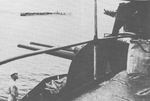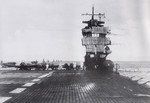Hiryu
| Country | Japan |
| Ship Class | Soryu-Class Aircraft Carrier |
| Builder | Yokosuka Naval Arsenal |
| Laid Down Date | 8 Jul 1936 |
| Launch Date | 16 Nov 1937 |
| Commission Date | 5 Jul 1939 |
| Sunk Date | 5 Jun 1942 |
| Displacement | 17,300 tons standard; 20,250 tons full |
| Length | 746 feet |
| Beam | 73 feet |
| Draft | 26 feet |
| Machinery | 8 Kampon boilers, 4 sets geared turbines, 4 shafts |
| Bunkerage | 4,400t oil, 150,000gal aviation fuel |
| Power Output | 153,000 shaft horsepower |
| Speed | 34 knots |
| Range | 10,330nm at 18 knots |
| Crew | 1,103 |
| Armament | 12x5in, 31x25mm anti-aircraft |
| Armor | 3.5in belt, 1in deck, 2.2in magazines |
| Aircraft | 57 operational, 16 in reserve |
| Flight Deck | 711.5 ft x 88.5 ft |
| Arrester Wires | 6 aft, 3 forward, all hydraulic |
| Elevators | 3 |
| Hangar Decks | 2 |
Contributor: C. Peter Chen
ww2dbaseHiryu was completed at Yokosuka, Japan in 1939. She was a member of Chuichi Nagumo's dreaded Mobile Force, and was one of the fleet carriers that launched the deadly attack on Pearl Harbor in Dec 1941. She participated in the Battle of Midway and launched the aircraft that disabled the American carrier Yorktown. Hiryu then came under attack by Yorktown's SBD aircraft, which fought through Hiryu's combat air patrol fighters and a flak barrage. Captain Susumu Kawaguchi, air officer aboard Hiryu, recalled that Hiryu was hit six times during the fourth and final attack on her. One of the bombs struck the forward elevator, two just aft of the forward elevator, three just forward of the after elevator. All bombs were aimed at her hinomaru painted on her flight deck, a proud symbol of the rising sun that ironically doubled as the bull's-eye to the American pilots.
ww2dbaseWhen he determined that Hiryu was unsaveable, her captain Tamon Yamaguchi gathered the 800 men who were still aboard the ship, including the wounded, on the flight deck near the bridge, and led them in yelling banzai three times toward Tokyo, followed by the playing of the national anthem. After the ceremony, the order to abandon ship was issued. It was recorded that Yamaguchi and Tomeo Kaku (Hiryu's captain) had this exchange as they shared naval biscuits and water while the ship being abandoned, the exchange signifying how much the two officers had in common.
ww2dbase"Let us enjoy the beauty of the moon", Yamaguchi said to Kaku.
ww2dbase"How bright it shines," Kaku responds.
ww2dbase"It must be in its 21st day."
ww2dbaseAdmiral Kusaka was aboard the Hiryu that day, and recalled Hiryu's commanders Rear Admiral Tamon Yamaguchi and Captain Tomeo Kaku.
ww2dbaseAfter the survivors were evacuated (without Yamaguchi, who remained on board to go down with the ship), destroyer Makigumo fired two torpedoes to scuttle her some time between 0905 and 0915 in the morning of 5 Jun 1942. The first torpedo passed under her, but the second hit her squarely in the hull.
ww2dbaseEnsign Mandai, who floated in the water nearby when Hiryu sank, saw the giant propellers rose above the waves as the bow of the ship dipped into the ocean. He swam vigorously to escape the suction created when a ship sank; when he dared to look again, Hiryu was gone.
ww2dbaseSources: Imperial Japanese Navy Page, Midway Dauntless Victory, the Pacific War, Shattered Sword, US Navy Naval Historical Center.
Last Major Revision: Sep 2008
Aircraft Carrier Hiryu Interactive Map
Photographs
 |  |  |  |
Hiryu Operational Timeline
| 5 Jul 1939 | Carrier Hiryu was commissioned into service. |
| 26 Nov 1941 | Vice Admiral Chuichi Nagumo led the Japanese Carrier Division 1 (Akagi and Kaga), Carrier Division 2 (Hiryu and Soryu), Carrier Division 5 (Shokaku and Zuikaku), first section of Battleship Division 3 (Hiei and Kirishima), Cruiser Division 8 (Tone and Chikuma), Destroyer Squadron 1, Destroyer Squadron 17, and Destroyer Squadron 18 out of Hitokappu Bay in the Kurile Islands for the Hawaii Operation, the attack on the US Pacific Fleet at Pearl Harbor, US Territory of Hawaii. |
| 12 Jan 1942 | Hiryu, Soryu, Ariake, and Yugure departed Hashirijima in Hiroshima Bay, Japan. |
| 17 Jan 1942 | Hiryu, Soryu, Ariake, and Yugure arrived at Palau, Caroline Islands at 1140 hours. |
| 21 Jan 1942 | Hiryu, Soryu, Ariake, Yugure, Ushio, and Sazanami departed Palau, Caroline Islands at 1600 hours for air strikes on Maluku Islands, Dutch East Indies. |
| 26 Mar 1942 | Vice Admiral Chuichi Nagumo's Japanese First Air Fleet, built around a nucleus of five aircraft carriers (Akagi, Hiryu, Soryu, Shokaku, and Zuikaku), and supported by battleships (Kongo, Hiei, Haruna, and Kirishima), cruisers (Tone, Chikuma, Abukuma), and destroyers, sailed from Staring Bay, Celebes, Dutch East Indies to the west of Timor into the Indian Ocean with the intention of attacking the Royal Navy's bases at Colombo and Trincomalee in Ceylon. |
| 3 Apr 1942 | The Japanese fleet under the command of Vice Admiral Chuichi Nagumo entered the Indian Ocean. |
| 5 Apr 1942 | In the morning, Japanese carriers launched 36 D3A2 dive bombers and 53 B5N2 torpedo bombers, escorted by 36 Zero fighters, against the British naval base at Colombo, Ceylon, sinking merchant cruiser HMS Hector, damaging port facilities, while shooting down 25 British aircraft; 7 Japanese aircraft were lost in this attack. Around noon, cruiser Tone's floatplane spotted British cruisers HMS Cornwall and HMS Dorsetshire 200 miles southwest of Ceylon; 53 carrier aircraft were launched to attack, sinking Dorsetshire at 1350 hours (234 killed) and Cornwall at 1400 hours (190 killed); 1,122 survived from both ships. |
| 9 Apr 1942 | Japanese carrier aircraft attacked the harbor at Trincomalee, Ceylon at 0700 hours. Two hours later, empty British aircraft carrier HMS Hermes and Australian destroyer HMAS Vampire were detected 90 miles further south. At 1035 hours, Japanese carrier aircraft attacked and sank HMS Hermes (307 killed) and HMAS Vampire (9 killed); hospital ship Vita rescued survivors from both warships. At 1207 hours, 20 Japanese carrier dive bombers sank British oiler Athelstane (all aboard survived) and British corvette HMS Hollyhock (48 were killed, 17 survived) in the Indian Ocean. |
| 19 Jun 1942 | US PBY Catalina aircraft discovered 35 survivors from the sunken Japanese carrier Hiryu; USS Ballard was dispatched to rescue them. |
Please consider supporting us on Patreon. Even $1 per month will go a long way! Thank you. Please help us spread the word: Stay updated with WW2DB: |
Visitor Submitted Comments
28 Feb 2007 02:54:48 AM
NO WERE THE IJN WAS FOOLISH IS EXSPECTING THE US NAVY WOULD REACT AS THEY THOUGHT THEY WOULD AND TAKEING TO LONG WITH CRUCIAL DESIONS!
17 Sep 2013 09:22:57 PM
The Americans always considered Soryu and Hiryu as being small carriers; actually, they were comparable in size to the USN Yorktown Class and were faster by about three knots (35Kn/hr) due to more powerful propulsion plants. Hiryu 153,000 HP; Yorktown 120,000 HP. Hiryu HP only exceeded by the two Shokakus (Shokaku, Zuikaku) that had 160,000 HP and were probably the best IJN carriers overall.
1 Jan 2022 08:53:53 PM
Lexington & Yorktown were (888 ft) 140 feet longer than Hiryu, and carried 78 vs 64 aircraft.
All visitor submitted comments are opinions of those making the submissions and do not reflect views of WW2DB.

» Amagai, Takahisa
» Kaku, Tomeo
» Minami, Yoshimi
» Yamaguchi, Tamon
» Yamaoka, Mineo
Event(s) Participated:
» Attack on Pearl Harbor
» Battle of Wake Island
» Raids into the Indian Ocean
» Battle of Midway and the Aleutian Islands
Document(s):
» Japanese Aircraft Carrier Functions
» Japanese Aircraft Carrier Operational Status By Month
» Japanese Aircraft Carrier Specifications
» Japanese Aircraft Carrier Time Operational
Partner Sites Content:
» Hiryu Tabular Record of Movement
- » 1,182 biographies
- » 337 events
- » 45,119 timeline entries
- » 1,249 ships
- » 350 aircraft models
- » 207 vehicle models
- » 376 weapon models
- » 123 historical documents
- » 261 facilities
- » 470 book reviews
- » 28,412 photos
- » 365 maps
Winston Churchill, on the RAF
Please consider supporting us on Patreon. Even $1 a month will go a long way. Thank you!
Or, please support us by purchasing some WW2DB merchandise at TeeSpring, Thank you!
28 Jan 2007 12:44:39 AM
Soryu and Hiryu were truly first class carriers, probably the best in the world in their day. Pity the dangfool IJN wasted them at Midway...